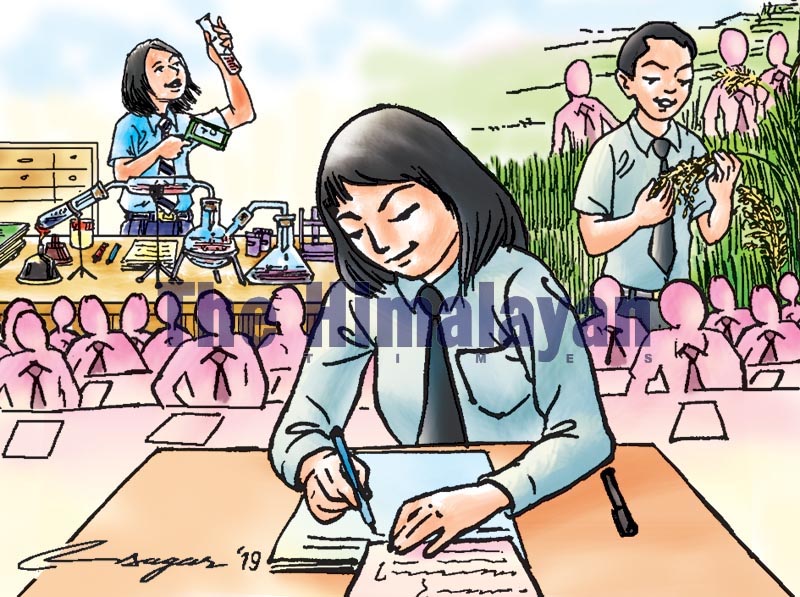Technical education: Focus on practical work
The focus of most of the schools is on the theory classes because of the tendency to award full marks in the practical exams, especially in the final exams conducted by the National Examination Board
After quitting my government job as technical sub-inspector in the Nepal Police, my interest in teaching, learning and exploring new things inspired me to work in a secondary school in a remote village in Sindhuli. The place and people were completely new to me, but the only thing I was looking for was a good working environment which could motivate me to work. Being a civil engineer, my friends and relatives were surprised to see me join a secondary school. But until society learns to respect this profession, no good politicians, moral and ethical government employees will be produced here.
On the very first day in the school, I was surprised to see children aged 11 or 12 in classes 9 and 10 talking about engineering survey, construction technology, auto-cad drawing, cost estimation and site supervision, which I had not heard in the Bachelor in Civil Engineering course. The government’s decision to open a technical school in every local level to produce competent manpower is indeed praiseworthy.
The civil engineering curriculum for classes 9 and 10 consists of theory of 40 per cent marks covering 68 learning hours and practical portion of 60 per cent marks of 102 learning hours. The course focusses on identification of different construction materials and their uses, masonry work, concrete work and finishing work. It gives them knowledge on water supply, waste management, site survey, carpentry and wiring. They also develop knowledge about building components, earthquake-resistant buildings, irrigation engineering, highway engineering, estimating the cost and site supervision, building drawing using modern drafting method, that is, auto-cad. Grade 11 course consists of geotechnical engineering, bio-engineering, gabion works, highway material and testing, basic structure knowledge and reinforced concrete structures.
During one interaction programme, a student from class 9 complained that the same subject had been taught by more than three teachers, and I was the fourth teaching it.
The tendency of teachers to drop out is high. The appointment of technical teachers is on contract basis only. The challenge is to retain competent and qualified technical instructors who could find better jobs in other sectors.
The focus of most of the schools is on the theory classes because of the tendency to award full marks in the practical exams especially in the final exams conducted by the National Examination Board. The curriculum states that the learning facilities should be enhanced through group discussion, field visits, demonstration, research, questionnaire, problem works, audio-visual class and other creative skills, but this is rarely the case. No laboratory guidelines and manuals have been developed for the instructors for practical work. So technical education looks more like non-technical education. Most of the labs are dirty with old equipment.
Student dropout after SEE is a major problem. Many students try to change their stream in grade 11, with some quitting studying altogether. All the courses to be taught in the technical and vocational stream have been designed in English, and engineering education requires good science and mathematical knowledge. But students are weak in mathematics, science and English. Many students in grades 11 and 12 fail in physics, chemistry and mathematics.
The quality of education needs to improve from zero level. There are teachers who do not even finish their course in time. Politics in the education sector has degraded the quality of education. Most of the schools lack a good educational environment. If the base level of a student is poor, how can students excel in technical education, which needs more effort in the higher classes?
In rural areas, it is difficult to get competent students, and it has been a compulsion to admit unqualified students to fill the quota. Some courses included in the curriculum have been designed in such a way that it is hard for the instructors to teach them at grades 9-12 level because many basic things which should be known are missing. The government has invested huge amount of money in opening more and more technical schools, but it has not studied what really is happening in the schools established in the earlier phase. First, the technical instructors should feel secure about their job so that they can work in a motivated way.
There is no monitoring unit to see how the vocational and technical stream is being run across the country. Many schools have raised fees under different headings for technical education in government schools. The government should make it clear what amount can be charged from the students. There is a lack of well-equipped laboratories though the government has allocated enough budget for this. Though the official guidelines have clearly stated one laboratory technician is a must in every school, some schools have yet to manage them.
Technical and vocational education should comprise less of theoretical knowledge and more of practical work. More practical work means more experience. The schools should build good relations with the relevant institutions. On-the-job work, which is the basis for teaching a student how to fish, should not be limited to paper certificates. The government should strongly monitor issues relating to the development of technical education.






